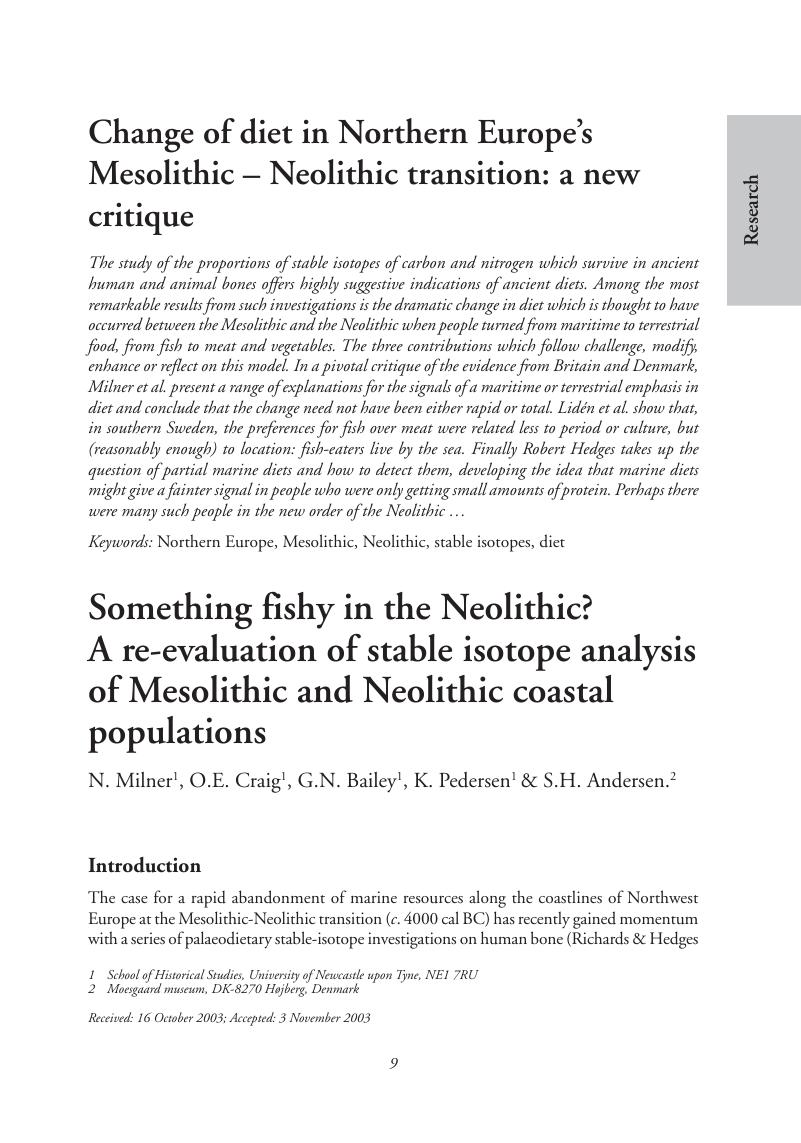Crossref Citations
This article has been cited by the following publications. This list is generated based on data provided by Crossref.
Borić, Dušan
Grupe, Gisela
Peters, Joris
and
Mikić, Živko
2004.
Is the Mesolithic–Neolithic Subsistence Dichotomy Real? New Stable Isotope Evidence from the Danube Gorges.
European Journal of Archaeology,
Vol. 7,
Issue. 3,
p.
221.
Barberena, R.
and
Borrero, L.A.
2005.
Stable isotopes and faunal bones. Comments on Milner et al. (2004).
Antiquity,
Vol. 79,
Issue. 303,
p.
191.
Balasse, Marie
Tresset, Anne
Dobney, Keith
and
Ambrose, Stanley H.
2005.
The use of isotope ratios to test for seaweed eating in sheep.
Journal of Zoology,
Vol. 266,
Issue. 3,
p.
283.
Forenbaher, Stašo
and
Miracle, Preston T.
2005.
The spread of farming in the Eastern Adriatic.
Antiquity,
Vol. 79,
Issue. 305,
p.
514.
Kimball, Michael J.
2006.
Common pools and private tools? Mobility and economy during Ireland’s Later Mesolithic.
Journal of Anthropological Archaeology,
Vol. 25,
Issue. 2,
p.
239.
Craig, O.E.
Ross, R.
Andersen, Søren H.
Milner, N.
and
Bailey, G.N.
2006.
Focus: sulphur isotope variation in archaeological marine fauna from northern Europe.
Journal of Archaeological Science,
Vol. 33,
Issue. 11,
p.
1642.
Lillie, Malcolm
and
Jacobs, Kenneth
2006.
Stable isotope analysis of 14 individuals from the Mesolithic cemetery of Vasilyevka II, Dnieper Rapids region, Ukraine.
Journal of Archaeological Science,
Vol. 33,
Issue. 6,
p.
880.
Dürrwächter, Claudia
Craig, Oliver E.
Collins, Matthew J.
Burger, Joachim
and
Alt, Kurt W.
2006.
Beyond the grave: variability in Neolithic diets in Southern Germany?.
Journal of Archaeological Science,
Vol. 33,
Issue. 1,
p.
39.
Richards, M.P.
and
Schulting, R.J.
2006.
Touch not the fish: the Mesolithic-Neolithic change of diet and its significance.
Antiquity,
Vol. 80,
Issue. 308,
p.
444.
Borrero, L. A.
and
Barberena, R.
2006.
Hunter‐Gatherer Home Ranges and Marine Resources.
Current Anthropology,
Vol. 47,
Issue. 5,
p.
855.
Kosiba, Steven B.
Tykot, Robert H.
and
Carlsson, Dan
2007.
Stable isotopes as indicators of change in the food procurement and food preference of Viking Age and Early Christian populations on Gotland (Sweden).
Journal of Anthropological Archaeology,
Vol. 26,
Issue. 3,
p.
394.
Bogaard, A.
Heaton, T.H.E.
Poulton, P.
and
Merbach, I.
2007.
The impact of manuring on nitrogen isotope ratios in cereals: archaeological implications for reconstruction of diet and crop management practices.
Journal of Archaeological Science,
Vol. 34,
Issue. 3,
p.
335.
MANNINO, M. A.
THOMAS, K. D.
LENG, M. J.
PIPERNO, M.
TUSA, S.
and
TAGLIACOZZO, A.
2007.
MARINE RESOURCES IN THE MESOLITHIC AND NEOLITHIC AT THE GROTTA DELL’UZZO (SICILY): EVIDENCE FROM ISOTOPE ANALYSES OF MARINE SHELLS*.
Archaeometry,
Vol. 49,
Issue. 1,
p.
117.
Douglas Price, T.
Ambrose, Stanley H.
Bennike, Pia
Heinemeier, Jan
Noe-Nygaard, Nanna
Petersen, Erik Brinch
Petersen, Peter Vang
and
Richards, Michael P.
2007.
New Information on the Stone Age Graves at Dragsholm , Denmark.
Acta Archaeologica,
Vol. 78,
Issue. 2,
p.
193.
Fischer, Anders
Olsen, Jesper
Richards, Mike
Heinemeier, Jan
Sveinbjörnsdóttir, Árny E.
and
Bennike, Pia
2007.
Coast–inland mobility and diet in the Danish Mesolithic and Neolithic: evidence from stable isotope values of humans and dogs.
Journal of Archaeological Science,
Vol. 34,
Issue. 12,
p.
2125.
CRAIG, O. E.
FORSTER, M.
ANDERSEN, S. H.
KOCH, E.
CROMBÉ, P.
MILNER, N. J.
STERN, B.
BAILEY, G. N.
and
HERON, C. P.
2007.
MOLECULAR AND ISOTOPIC DEMONSTRATION OF THE PROCESSING OF AQUATIC PRODUCTS IN NORTHERN EUROPEAN PREHISTORIC POTTERY*.
Archaeometry,
Vol. 49,
Issue. 1,
p.
135.
Fischer, Anders
Richards, Mike
Olsen, Jesper
Robinson, David Earle
Bennike, Pia
Kubiak-Martens, Lucyna
and
Heinemeier, Jan
2007.
The composition of Mesolithic food.
Acta Archaeologica,
Vol. 78,
Issue. 2,
p.
163.
Laurie, Eva
2007.
Cockle Conversations: An investigation of the cockle collection practices at two Danish kitchen midden sites.
Internet Archaeology,
Triantaphyllou, S.
Richards, M.P.
Zerner, C.
and
Voutsaki, S.
2008.
Isotopic dietary reconstruction of humans from Middle Bronze Age Lerna, Argolid, Greece.
Journal of Archaeological Science,
Vol. 35,
Issue. 11,
p.
3028.
Olsen, Jesper
Heinemeier, Jan
Bennike, Pia
Krause, Cille
Margrethe Hornstrup, Karen
and
Thrane, Henrik
2008.
Characterisation and blind testing of radiocarbon dating of cremated bone.
Journal of Archaeological Science,
Vol. 35,
Issue. 3,
p.
791.


